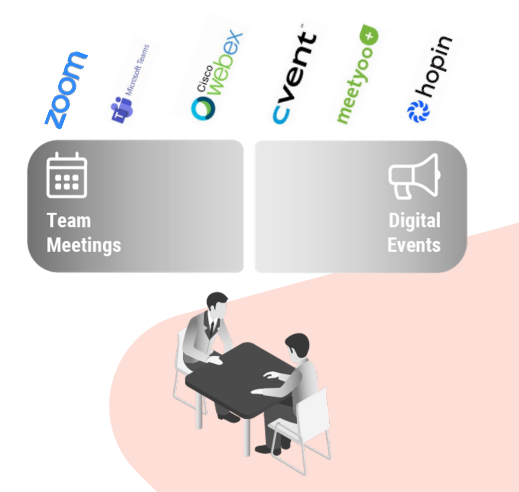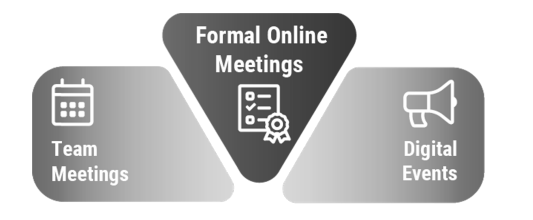During the pandemic, a €5.5 billion market for Formal Online Meetings has emerged. Digital providers now have a unique opportunity to help shape this market. Insights from the field at Linkando, and the assessment of Thomas Gebhart, member of the Bundestag.
A guest article by Volker Wiora, founder and CEO at Linkando
Digital business models flourished during the Corona crisis, that's no secret: the share prices of companies like Microsoft and Apple speak for themselves. However, completely new markets also emerged during the pandemic - for example, for Formal Online Meetings (FOMs).
FOMs are meetings and gatherings that must follow formal guidelines - for example, shareholder meetings, association and society meetings, or board meetings. In contrast, informal meetings such as team meetings usually do not follow any particular guidelines.
Meetings before the pandemic
Before the pandemic, the digital meetings market was divided into two worlds: On the one hand, small-scale video conferencing, for example team meetings, covered by providers such as Zoom, Microsoft Teams or Cisco Webex. On the other hand, large events such as marketing events or conferences, with cvent, meetyoo or hopin being the leading providers.

Formal meetings, on the other hand, were exclusively offline events before the pandemic, as digital formats were usually not desired for this type of meeting.
There were two main reasons for this:
First, the legal situation was unclear, because many relevant questions had never been asked before: Are digitally held votes and elections legally valid? How must minutes be kept? What formal requirements must invitations and the event schedule meet?
Second, participants in Formal Meetings preferred the offline format: there was little trust in digital technology, and there was little experience, both with digital platforms and with digital conviviality and argument culture.
New meeting culture
The pandemic created a new situation: Due to lockdowns and contact restrictions, online meetings were now the only format available.
In order to create legal certainty, changes in the law were initiated. In addition, both organizers and meeting participants were now forced to gain experience with digital technology. And lo and behold: it worked!
For example, the CDU held its national party conference online for the first time in early 2021. The 1,001 delegates met virtually and voted from home.
Thomas Gebhart, a member of the Bundestag for the CDU, describes his experience: "It was pretty much uncharted territory. We were forced to switch to such [online] systems from now on during the pandemic. Despite the challenges, everything worked great."
A new market
In the meantime, we have become accustomed to the tools and appreciate their advantages. Online meetings save time and money, enable efficient preparation and follow-up, and create planning reliability. The new situation has opened up the space for FOMs and created a completely new market.

FOMs have come to stay. Because even after the Corona pandemic, physical events remain fraught with risk: Train strikes, storms, cancellations due to illness - online meetings, on the other hand, can be dialed in from the comfort of home.
Formal meetings will therefore increasingly be held online in the future. But it doesn't have to be an either-or decision between a face-to-face meeting or an online event. Hybrid meeting formats offer organizers the option of inviting participants both online and offline. This makes it possible to reschedule at the last minute: If participants are unable to attend, they simply dial in online and the meeting takes place smoothly. At the same time, the physical event also gives people the opportunity to meet in person.
Thomas Gebhart also sees the future in hybrid event formats. "It has to continue in a hybrid world, because these online formats offer a great many advantages," Gebhart says. "Today, people do these things via video conferencing as a matter of course. We have to preserve that because it saves time and also has a climate protection aspect. It would be fatal if we were to fall back into old times."
Unique Opportunity
The FOM market is huge: Over 100 million formal meetings are held annually in Germany alone, of varying sizes. According to our estimates, the German FOM market is worth around 5.5 billion euros per year, and the trend is rising.
Digital formats offer cost-saving potential at all stages, from the organization of meetings to their execution and follow-up. With a holistic FOM solution, the operational costs of formal meetings can be reduced by up to 70% through standardization and automation.
Today, large and critical meetings in particular are organized as hybrid formats. In this market segment, FOMs have already become the standard. In the next step, FOMs will also become the norm for medium-sized and small meetings. Companies will carry the appropriate tools in their repertoire as standard, just as Zoom or Microsoft Teams are part of everyday life in most companies today.
To achieve this, a wide range of everyday solutions are needed: Video software, data protection and compliance solutions, digital signatures and automated texting are just a few examples. The FOM market offers huge potential for a wide range of vendors to establish themselves as market leaders already.







